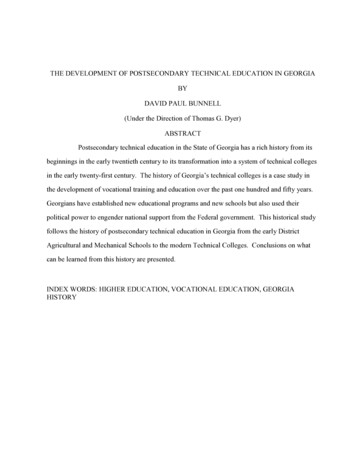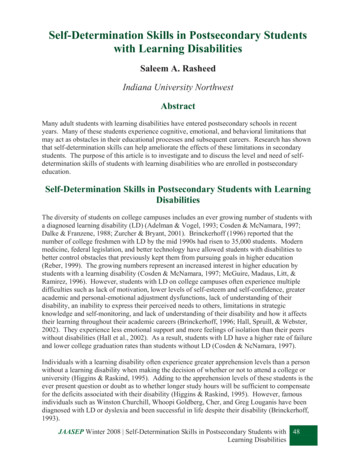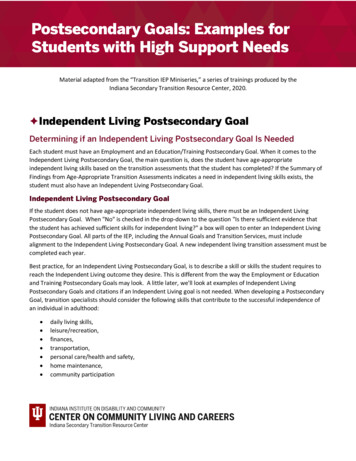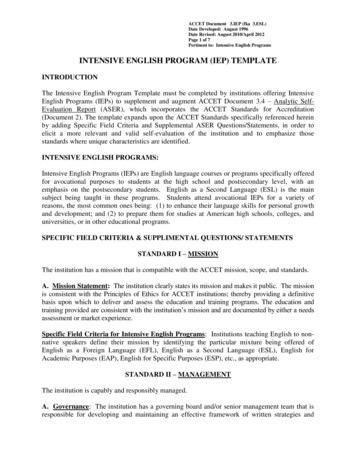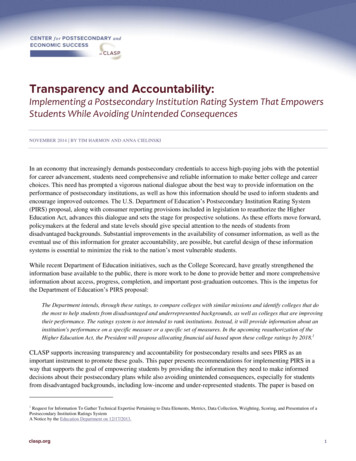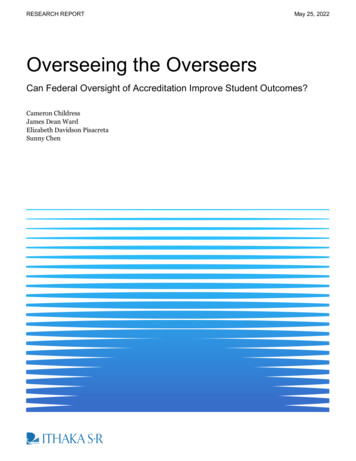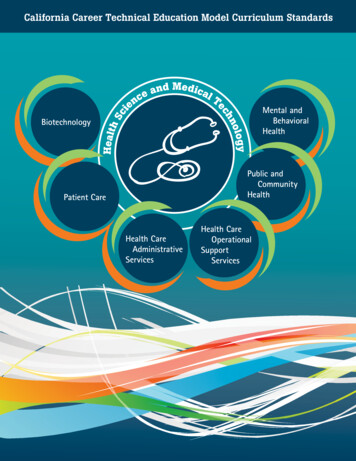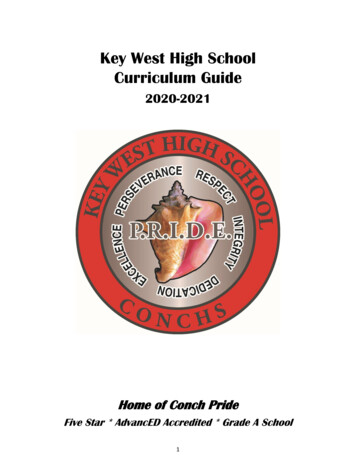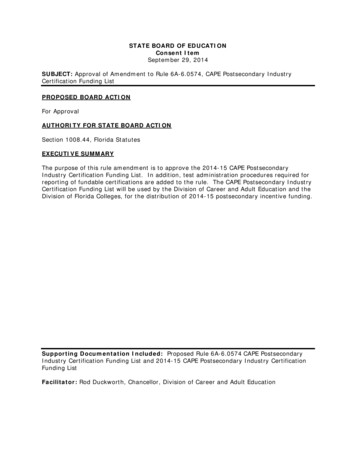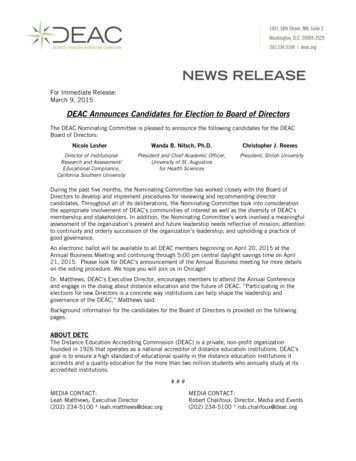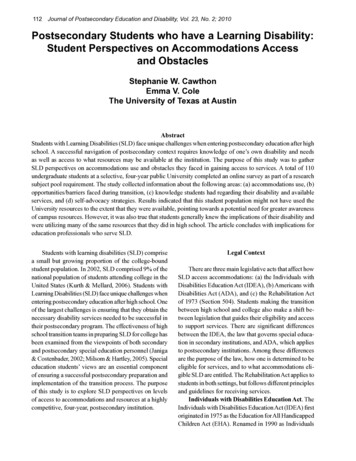
Transcription
112 Journal of Postsecondary Education and Disability, Vol. 23, No. 2; 2010Postsecondary Students who have a Learning Disability:Student Perspectives on Accommodations Accessand ObstaclesStephanie W. CawthonEmma V. ColeThe University of Texas at AustinAbstractStudents with Learning Disabilities (SLD) face unique challenges when entering postsecondary education after highschool. A successful navigation of postsecondary context requires knowledge of one’s own disability and needsas well as access to what resources may be available at the institution. The purpose of this study was to gatherSLD perspectives on accommodations use and obstacles they faced in gaining access to services. A total of 110undergraduate students at a selective, four-year public University completed an online survey as part of a researchsubject pool requirement. The study collected information about the following areas: (a) accommodations use, (b)opportunities/barriers faced during transition, (c) knowledge students had regarding their disability and availableservices, and (d) self-advocacy strategies. Results indicated that this student population might not have used theUniversity resources to the extent that they were available, pointing towards a potential need for greater awarenessof campus resources. However, it was also true that students generally knew the implications of their disability andwere utilizing many of the same resources that they did in high school. The article concludes with implications foreducation professionals who serve SLD.Students with learning disabilities (SLD) comprisea small but growing proportion of the college-boundstudent population. In 2002, SLD comprised 9% of thenational population of students attending college in theUnited States (Kurth & Mellard, 2006). Students withLearning Disabilities (SLD) face unique challenges whenentering postsecondary education after high school. Oneof the largest challenges is ensuring that they obtain thenecessary disability services needed to be successful intheir postsecondary program. The effectiveness of highschool transition teams in preparing SLD for college hasbeen examined from the viewpoints of both secondaryand postsecondary special education personnel (Janiga& Costenbader, 2002; Milsom & Hartley, 2005). Specialeducation students’ views are an essential componentof ensuring a successful postsecondary preparation andimplementation of the transition process. The purposeof this study is to explore SLD perspectives on levelsof access to accommodations and resources at a highlycompetitive, four-year, postsecondary institution.Legal ContextThere are three main legislative acts that affect howSLD access accommodations: (a) the Individuals withDisabilities Education Act (IDEA), (b) Americans withDisabilities Act (ADA), and (c) the Rehabilitation Actof 1973 (Section 504). Students making the transitionbetween high school and college also make a shift between legislation that guides their eligibility and accessto support services. There are significant differencesbetween the IDEA, the law that governs special education in secondary institutions, and ADA, which appliesto postsecondary institutions. Among these differencesare the purpose of the law, how one is determined to beeligible for services, and to what accommodations eligible SLD are entitled. The Rehabilitation Act applies tostudents in both settings, but follows different principlesand guidelines for receiving services.Individuals with Disabilities Education Act. TheIndividuals with Disabilities Education Act (IDEA) firstoriginated in 1975 as the Education for All HandicappedChildren Act (EHA). Renamed in 1990 as Individuals
Cawthon & Cole; Accommodations Access and Obstacleswith Disabilities Education Act (IDEA), it has beenreauthorized about every five years, the latest in 2006(as Individuals with Disabilities Education ImprovementAct, or IDEIA). IDEA specifically lists areas in whichdisabilities may occur, including a learning disability.The purpose of the law is to identify eligible students andprovide services to them that are educationally focusedand aimed at helping the student achieve academicallyto the best of their ability. These services are to be givenat no cost to the student or their families. Once a childis determined to have a learning disability, schools arerequired to provide an Individualized Education Program (IEP) plan. When a student reaches high school,the role of this IEP plan is not only to identify anddocument current services, but also to articulate whatthe student’s postsecondary goals might be. As early asage 14 and no later than age 16, the IEP team must meetwith the student (and parents) and lay out a plan for thetransition from high school into the student’s chosenpostsecondary setting, one of which may be college ora university.Americans with Disabilities Act. When a SLDenters a postsecondary institution, or more specifically,when they attain the age of majority (18-years-old),they have the option to seek protection under ADA.Passed in 1990, the ADA is a federal civil rights law thatprotects all persons with disabilities from discrimination. Unlike IDEA, where the school is responsible forproviding services, under ADA the student must initiatethis process, and is not entitled to protection if they donot inform the school of their disability. Additionally,unlike IDEA, ADA does not provide explicit guidelineson how to determine if a person has a learning disabilityor who makes that determination. The ADA states thata person has a disability if the individual has a “physical or mental impairment that substantially limits oneor more of the major life activities of such individual,the individual has a record of such an impairment; or isregarded as having such impairment” (Americans withDisabilities Act, 1990). Once a person is considered tohave a learning disability under ADA they are entitledto accommodations that enable persons with disabilitiesto engage in activities at the same level as their peerswithout a disability. Unlike IDEA, ADA accommodations are not necessarily educationally focused. Thereis more flexibility in the kinds of services that can beobtained through ADA.Rehabilitation Act. A precedent to later legislationsuch as the ADA (1990), the Rehabilitation Act of 1973113prohibited discrimination by federal agencies and by federally funded programs. Following the lead of reformssuch as those initiated by Brown v. the Board of Education, the Rehabilitation Act was passed during the civilrights era and reflects the focus on access and inclusiveparticipation in publicly funded institutions. Becausemost school districts and universities in the countryreceive federal aid, Section 504 of the RehabilitationAct effectively covers all students in public educationfrom discrimination or limited access to services on thebasis of a disability. Section 504 has a broad definitionof disability:Under this law, individuals with disabilities aredefined as persons with a physical or mental impairment which substantially limits one or more majorlife activities. People who have a history of, or whoare regarded as having a physical or mental impairment that substantially limits one or more majorlife activities, are also covered. Major life activities include caring for one’s self, walking, seeing,hearing, speaking, breathing, working, performingmanual tasks, and learning. Some examples ofimpairments which may substantially limit majorlife activities, even with the help of medicationor aids/devices, are: AIDS, alcoholism, blindnessor visual impairment, cancer, deafness or hearingimpairment, diabetes, drug addiction, heart disease,and mental illness. (United States Department ofHealth and Human Services, n.d.)Applied to schools, Section 504 requires schools atboth the secondary and postsecondary level to providenecessary accommodations for students with disabilities.Adequate access to curriculum is the central questionwhen a school or district is asked to provide services toa student with a disability. The Rehabilitation Act doesnot require that the student be designated as a specialeducation student in order to receive these services, nordoes it require the district or university to pay for theseservices, particularly if it would cause an undue burdenon the institution. In this way, the Rehabilitation Act isa less codified legislation than other avenues for receiving accommodations in public schools. The long-termimpact of the Rehabilitation Act was, in part, to put language into place that includes students with disabilitiesinto larger educational reforms.
114 Journal of Postsecondary Education and Disability, Vol. 23, No. 2; 2010Planning for Postsecondary EducationIDEA requires that the student be an active participant in the transition process from the secondary topostsecondary setting. For example, student presence isrequired at all IEP transition meetings and it is preferredthat students take an active role in the formation of theirIEP. The intent is to provide students with critical knowledge and information that prepares them to advocatefor themselves when they reach college. Knowledge ofdisability, knowledge of postsecondary support services,and the ability to self advocate have been identified ascontributors successful high school to college transitionsfor SLD (Milsom & Hartley, 2005).Potential obstacles to transitions. Within thetransition experience there are many potential obstaclesthat may hinder a successful transition from secondaryto postsecondary institutions. The first obstacle can be atearly stages of the transition process. The reauthorizationof IDEA required that students be present and activelyinvolved in their IEP meetings (Hammer, 2004). Whenstudents do attend their meetings parents report that theyunderstand the meeting better and feel more comfortableexpressing their opinions, while teachers are more likelyto express the SLD interests, talents, and requirements.Both parents and teachers feel more optimistic aboutthe IEP meeting with student attendance. However,a majority of students historically do not have the opportunity to participate in the formation of their IEPs(Reusen & Bos, 1994). Research investigating rates ofstudent participation in the IEP process indicate that 35%of states failed to invite students to participate in theirIEP meetings (Williams & O’Leary, 2001).The effects for a student can be felt over time; onlyabout half of students ever attend their IEP meetings(Mason, Field, & Sawilowsky, 2004). Even if studentsare able to attend their IEP meetings, active involvement by the student in IEP formulation is still difficultto achieve (Mason et al., 2004). Although research(Martin et al., 2006) has shown that 40% of specialeducation teachers believe that SLD participate in theirIEP meetings “a lot”, in reality students only talk forabout 3% of the meeting time. It is not surprising thatMason et al. (2004) found that only 34% of IEP teammembers reported that they were satisfied with the levelof student involvement in IEP meetings. Students whodo attend their meetings have many opportunities wherethey could become involved, such as expressing theirinterests and closing out the meeting. However, withoutprior preparation for these meetings, students often feellost and do not understand what’s going on, contributing to their conceptualization that the IEP meeting is ameaningless activity (Martin et al., 2006).From a service provider perspective, Janiga andCostenbader (2002) researched college administratorsatisfaction with the bridge between services in highschool to the postsecondary setting. This research foundthat administrators were not satisfied with the overalltransition services secondary students were provided,with the average satisfaction score rating 2.8 out of 10(Janiga & Costenbader, 2002). Specifically, administrators felt that students (a) lacked self-advocacy skills;(b) entered postsecondary institutions without an understanding of the difference between high school andcollege in class size, instructional time, teaching andexamination methods; (c) didn’t understand their ownstrength and weaknesses and the specific accommodations that they need; (d) couldn’t function independentlywithout relying on parents or special education teachers;and (e) disability assessments lacked adequate documentation for specific accommodations.Participants in this study felt that students’ lack ofinvolvement in their transitional IEP may contribute topotentially lower levels of academic preparedness toenter their chosen postsecondary institution and, morerelevant to this discussion, an unawareness of the accommodations they may need to succeed in such aninstitution (Janiga & Costenbader, 2002). Universityfaculties also cite their own level of disability knowledgeas inadequate. Faculty report that they feel that they donot have an adequate understanding of disability law,enough of an understanding of specific learning disabilities (LD) to create accommodations for students,and that they aren’t accustomed to working with thedisability offices at their institution (Murray, Flannery, &Wren, 2008). Overall less than 18% of faculty reportedthat they were knowledgeable about section 504 of theRehabilitation Act; 50% reported being familiar withADA (Thompson, Bethea, & Turner, 1997).Level of knowledge. When student knowledgeof disability, disability law, and accommodations areexamined, research has found that students know moreabout the services that their special education programprovides than about what is on their IEP, or knowledgeabout their specific disability. Schreiner (2007) askedhigh school SLD who were about to graduate to composeclassroom situations where they may encounter difficulties because of their LD and then explain how they
Cawthon & Cole; Accommodations Access and Obstacleswould communicate their needs and find help. Essayswere scored on realism about possible difficulties, adequacy in telling others of their difficulty, and adequacyin seeking help. The average score of these studentswas 18.22 out of 36 points, with no students scoringabove 22.41 points. Schreiner (2007) suggests that thepoor performance of SLD on this task indicates a lackof self-awareness and self-advocacy skills. Similar findings have also been reported by Cummings, Maddux, &Casey (2000), who found that SLD may not be effectiveadvocates because they lack understanding about theirstrengths and weaknesses, and are inadequately preparedto communicate these to their universities.Accommodations in Postsecondary SettingsAfter transition to college, SLD usually have arange of accommodations available to them. ADA andSection 504 mandate that services provided by postsecondary institutions must only provide students withan equal opportunity to learn, it does not require thatschools provide accommodations that would provideequal results with non-disabled peers (Brinckerhoff,Shaw, & McGuire, 1992). Universities must providean accommodation if it does not fundamentally alterthe program of study and does not produce excessivefinancial or logistical hardship. If an accommodationis found to be unreasonable the university must onlyprovide the most basic accommodation (e.g. providinga student with dysgraphia with a note taker instead ofa course transcript) (Brinckerhoff, Shaw, & McGuire,1992). A national survey of 98% of all institutions withat least one student with a disability provided a minimumof one support service. Reported accommodation ratesvaried: 88% of all institutions offered extended time,77% provided tutors, 69% supplied note takers, 62%made class registration assistance available, 55% offeredtext on tape, 58% provided adaptive technology, and45% made sign language interpreters available (Janiga& Costenbader, 2002).However, many SLD students rate these accommodations as ineffective as often as 25% of the time (Kurth& Mellard, 2002). Kurth and Mellard hypothesizedthat many accommodations offered by universities areineffective and inappropriate because they assign accommodations based on the student’s disability ratherthan understanding what a SLD will practically need intheir classroom environment. From a SLD perspective,accommodations are often selected based on multiple115factors, including the effectiveness and availability ofthe accommodation, as well as the amount of increasedindependence associated with the accommodation andthe ease of use. Of these factors, effectiveness of theaccommodation was reported as the most importantby SLD (Kurth & Mellard, 2002). SLD students ratednote takers, extended time on tests, adaptive technology,preferential classroom seating, and public transportationas being effective 80-88% of the time. Tutoring services,tape recorders, alternate test locations, taped text/notes,and mental health services were considered effective64-78% of the time.Potential Barriers to AccessEven if students receive effective accommodations,they still may encounter many obstacles in the courseof their education. In fact, up to 86% of SLD mayencounter some type of barrier in their postsecondaryeducation (West et al., 1993). One of the major potentialareas for the development of obstacles is faculty/SLDinteractions. Research has found that faculty membersconsider themselves to have positive attitudes towardSLD and are willing to accommodate and advocate forSLD in their classes (Murray, Flannery, & Wren, 2008;Debrand & Salzberg, 2005). A high percentage (80%)of faculty wanted to know what their responsibilities aretowards SLD and many want to give additional time andhelp to SLD (Salzberg et al., 2002).Yet, even if faculty members do report mainly positive interactions with SLD, students often do not feelthe same way. Interviews conducted with SLD indicatethat they often lack a sense of belonging (Kurth &Mellard, 2002). SLD sometimes felt that faculty eitherbelieves that they are incompetent and must “help” themsucceeded, or that SLD should not be enrolled in theirclasses altogether. Additionally, some students felt thatthey have difficulty accessing academic informationbecause their professors do not know how to properlyaccommodate them, that faculty are unwilling to providespecific accommodations, or that the accommodationprovided by the university was unsubstantial (e.g. anote taker whose handwriting was illegible). Finally,some students feel discriminated against whether inonly perception or in reality (Kurth & Mellard, 2002).The potential barriers many SLD face are important tounderstand as they highlight the need at the high schoollevel for high quality transition services that create SLDwith high levels of self-awareness and self-advocacy
116 Journal of Postsecondary Education and Disability, Vol. 23, No. 2; 2010skills. At the college level, it illustrates the need foreffective and adequate accommodations, and facultyeducation and support for working with SLD.Study ObjectivePrevious studies looking at transition services forSLD focused mainly on how high school and collegecounselors view the transition process (e.g. Milsom &Hartley, 2005). Under the ADA ,students are ultimatelyresponsible for ensuring that they receive the servicesthey need so it is important to ask the students directlytheir perspectives on accessing accommodations, whenneeded. This study explores the possible effects of keyvariables that could influence how SLD access servicesonce in the university setting: student level of knowledge about their disability; transition services providedby their high school programs; skills to advocate forthemselves in a college setting; and their experienceswith peers, faculty, and administration at the postsecondary level.The context of this study is the student experienceaccessing resources in a highly competitive, four-year research-intensive university. This population is importantbecause, in secondary institutions, high-achieving SLDwere competing with a peer group composed of varyingacademic abilities. However, once they reach college,SLD compete with other high achieving students and ahigher level of academic competence will be expectedof them (Dexter, 1982). In this competitive environment,even high achieving SLD may find themselves withacademic difficulties that they never experienced before.Three research questions guide this study:1. Are there differences between the accommodations and services SLD received in highschool and what they now receive in thisuniversity setting?2. What opportunities or barriers did SLD face inthe accessing services at the university?3. What level of knowledge do SLD have regarding their disability, available services, andstrategies for self-advocacy?MethodPopulation and SampleParticipants were undergraduate SLD who wereenrolled in an education department subject pool at alarge, public, research one University. Undergraduateenrollment at the University is 37,459 students. TheUniversity is highly selective in its student admissionsprocess. Students who are in the top 10% of their classhave automatic acceptance to a state university, including the study site. In 2008, 81% of students at the University were admitted under the 10% rule, with a meanGPA of 3.08 and mean SAT of 1219. The student bodyis diverse, with 51% White/Non-Hispanic, 20% Hispanic, 20% Asian/Pacific Islander, and 6% Black/NonHispanic. The department subject pool from which thissample was drawn was made up of 1,297 students, withsimilar ethnic distribution as the overall undergraduateenrollment at the University (Lavergne & Walker, 2008).A total of 1,161 students utilized disability services atthe University in 2007, with roughly equal proportionsof men and women. However, the ethnic distribution ofstudents accessing services was more heavily skewedtowards students who were White (70%), with lowerproportions of Asian (7%) and Hispanic (14%) than inthe overall student population. Of the 1,161 studentswho accessed University services, 15.7% had a specificlearning disability (Shultz-Hampton, 2008).A total of 110 participants completed the study.Unless otherwise indicated, all results in this studyare reported as a percentage of the 110 participants.We first asked participants when they were diagnosedwith a learning disability. Students responded across awide range of time periods. Roughly a third, or 28%of students, were diagnosed before 7th grade. Another43% were diagnosed either in middle (7th-8th grade) orhigh school (9th-12th grade). A small percentage, 5%,indicated that they were diagnosed in college. About asixth of students (16%) were not sure when they werediagnosed. The remainder of the students (7%) indicatedthat they did not receive a formal diagnosis of a learning disability.We then asked participants whether they knew whatdiagnosis process was used to determine their learningdisability. A total of 30% of students indicated that theywere diagnosed using an IQ discrepancy model and 14%checked the Response to Intervention option1. However,1An IQ Discrepancy Model is a method of diagnosing a specific LD; diagnosed if there is at least a Standard Deviation be-
Cawthon & Cole; Accommodations Access and Obstacleseven with these designations, the majority of participants(71%) indicated that they were not sure about theirdiagnosis. Students were more certain about the kindof LD that they had. Only 15% were unsure as to thenature of their LD. Participants could check more thanone kind of LD in their responses. Most were related toa reading or language processing skill. A total of 32%indicated that they had a listening or auditory comprehension disability, 35% had a reading (e.g. decoding,comprehension, fluency) disability, 16% had a writingdisability (e.g. spelling, sentence structure), and 8% hada mathematics disability (e.g. computation, problemsolving). In addition to LD, some students indicatedthat they had disabilities such as ADHD (10%), bipolar(3%), or anxiety (1%).RecruitmentParticipants were recruited from an undergraduate Educational Psychology Subject Pool (SP) at theUniversity. Recruitment occurred during the 2007-2008and 2008-2009 academic years. The SP was composedof students from four undergraduate classes: IndividualLearning Skills, Human Sexuality, Adolescent Development, and Introduction to Statistics. As part of their coursecredit, students had the option of either participating inresearch studies or completing an alternate essay assignment. At the start of the recruitment process, studentsfilled out an SP screening questionnaire. Researchers wereallowed to include questions that related to the specificsof the needed samples. The researchers in this study included information about the grade level of the studentand whether they self-identified as a SLD. Students whoindicated that they had LD and who were sophomores orolder were invited to participate in the survey.Survey InstrumentThe data for this study was collected in the form ofan online survey. The survey was piloted before the mainstudy to estimate the length of participation (about 15minutes). The survey format included multiple choicequestions, Likert scale, check-list questions, and openended questions. The survey was administered throughSurvey Monkey at http://www.surveymonkey.com/.Once students were recruited via the University SP,participants were provided the link to the online survey.tween a child’s IQ and achievement in a specific academic area.A Response to Intervention Model diagnoses LD students byenrolling them in progressively intensive remediation services.Students who do not make adequate progress when placed in themost intensive remediation level are considered LD.117Students provided a unique identifier (student ID) thatboth allowed for follow-up with participants if therewere questions and to verify that each person completedthe survey only once. After they were finished, studentsreceived an e-mailed receipt for their participation thatwas used to document fulfillment of the course requirement. Students had approximately six weeks to completethe study.The survey (see Appendix A) asked participantsto provide information about the accommodationsand services they received a) in high school and b)during their undergraduate experience (thus far). Thisinformation was gathered using both a checklist andopen-ended questions. To gather accommodation information, students were provided with a list of commonaccommodations and asked to check if they receivedthose accommodations in high school and if they hadreceived these accommodations in college. To gatherinformation about transition experience, students wereasked to answer a series of open-ended question aboutexperiences in the transition.AnalysisWe used a mixed-methods approach to data analysisfor this study. Data analysis for each of the researchquestions is as follows:1. Are there differences in the accommodationsand services SLD received in high school andwhat they now receive in college?The questions related to specific services only provideddescriptive data. Results from both checklists, onefor high school and one for college, were analyzed insummative form (percent of respondents indicatingeach type of accommodation or service). Results wereanalyzed using the Chi Square method to determine ifaccommodations and services used in high school wereused to the same extent at the University. There werealso several open-ended questions about services oraccommodations. After all responses were reviewed,they were independently coded by two researchers ona set of content themes that emerged from the data. Thecoding process was repeated until there was 100% agreement on coded categories. Results were aggregated insummative form (i.e. percent of respondents addressingeach topic).
118 Journal of Postsecondary Education and Disability, Vol. 23, No. 2; 20102. What opportunities or barriers did SLD face inaccessing services at the university?This research question was answered using theopen-ended questions in the second portion of the surveyabout experiences at the University. After all responseswere reviewed, they were independently coded by tworesearchers on a set of content themes that emerged fromthe data. The coding process was repeated until therewas 100% agreement on coded categories. Results wereaggregated in summative form across the categories ofopportunities and barriers.3. What level of knowledge did SLD have regarding their disability, available services, andstrategies for self-advocacy?This research question was answered using descriptive data from questions regarding the transitionpreparation process. Results from both checklists wereanalyzed in summative form (i.e. percent of respondentsindicating each type of preparation activity).ResultsAccommodations and ServicesFigure 1 summarizes the accommodations andservices SLD receive in high school (HS) and now atthe University (only those with statistical differencesin overall frequency are shown in the Figure). Studentswere presented with 16 accommodation options andasked to indicate which accommodations they receivedin each institution and who provided them. The sourcePhysicalTherapyAlternate Extended Separate IndividualorAssistive Classroomformattime on setting counseling functionaltechnology assistants Tutoringteststestsfor tests or therapy trainingOtherFigure 1. Mentoring ModelUTAccommodationsHSUTProvided by SchoolHSUTProvided by ParentsHSProvided by Other SourceUTHSProvided by OSDUTHSProvided by SelfUTProvided by MultipleSourcesHSUTProvided by Mixed UTSourcesHSProvided by Other UniversitySourceUTHSProvided by MixedParent/University SourcesUTHS0%10%20%30%40%50%Figure 1 Note. This figure provides information on the overall prevalence and source of accommodations students received in High School(HS) and then at the University. Participants (N 110) checked off the accommodation (on the y-axis) the location (UT vs. HS), and thesource (provided by school, parents, other s
United States (Kurth & Mellard, 2006). Students with Learning Disabilities (SLD) face unique challenges when entering postsecondary education after high school. One of the largest challenges is ensuring that they obtain the necessary disability services needed to be successful in their postsecondary program. The effectiveness of high
